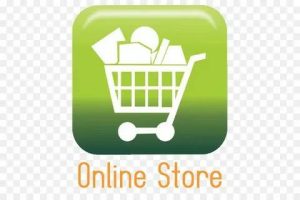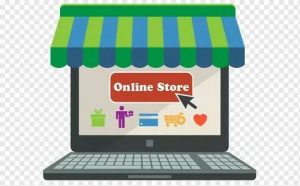An online store, also known as an e-commerce store or an online shop, is a website or platform where businesses or individuals sell products or services over the internet. It is a digital counterpart to traditional brick-and-mortar retail stores, providing customers with the ability to browse, select, and purchase products online.
An online store typically includes the following components:
- Product Catalog: An organized listing of products or services available for purchase. Each product listing includes relevant details such as descriptions, images, prices, and specifications.
- Shopping Cart: A virtual shopping cart or basket that allows customers to add products they wish to purchase. It keeps track of selected items and calculates the total cost.
- Payment Gateway: Integration with secure payment gateways that facilitate online transactions. This allows customers to make payments using various methods such as credit cards, debit cards, digital wallets, or other online payment options.
- Order Management: The system manages the processing, fulfillment, and tracking of customer orders. It includes features like order confirmation, shipment notifications, and order history for both customers and the store owner.
- User Accounts: Customers can create accounts to store their personal information, order history, and shipping addresses. User accounts provide a convenient and personalized shopping experience, allowing customers to save their preferences and track their orders.
Overall, an online store provides a platform for businesses to showcase and sell products or services online, offering customers the convenience of shopping from anywhere at any time. It simplifies the buying process, enables secure transactions, and provides a range of features and functionalities to enhance the shopping experience.
Product Catalog
The product catalog is a fundamental component of an online store. It serves as a comprehensive and organized collection of all the products or services available for purchase. Here are some key aspects of the product catalog:
- Product Listings: The product catalog includes individual listings for each item or service offered by the online store. Each listing typically includes essential information such as the product name, description, specifications, pricing, availability, and images. The listings provide customers with detailed information about the products they are interested in.
- Categorization and Navigation: The product catalog is typically organized into categories and subcategories to facilitate easy navigation. Categorization helps customers quickly find the products they are looking for and allows them to browse specific product groups. Clear and intuitive navigation within the catalog enhances the overall user experience.
- Search Functionality: An online store’s product catalog often includes a search bar that enables customers to search for specific products or keywords. The search function helps customers quickly locate desired items, especially when they have a specific product in mind. Advanced search filters may also be available to refine search results based on criteria such as price range, brand, or product attributes.
- Product Details and Descriptions: Each product listing within the catalog includes detailed information and descriptions. This may include features, specifications, dimensions, materials, care instructions, and any other relevant details that help customers make informed purchasing decisions. Compelling and accurate product descriptions are crucial for engaging customers and providing accurate expectations.
- Product Images and Videos: High-quality product images are essential in an online store’s catalog. Multiple images from different angles, zoom-in capabilities, and product videos enhance the visual representation of the products, giving customers a better understanding of the item’s appearance, features, and functionality. Rich media assets help customers make purchasing decisions with more confidence.
An organized and well-maintained product catalog is vital for providing a seamless and engaging shopping experience. It helps customers find and explore products easily, access relevant information, and make informed purchasing decisions, ultimately contributing to the success of an online store.
Shopping Cart
The shopping cart is a crucial component of an online store that enables customers to gather and manage the items they intend to purchase. It serves as a virtual basket or container where customers can add, review, and modify the products before proceeding to the checkout process. Here are the key aspects of the shopping cart in an online store:
- Adding Products: Customers can add desired products to their shopping cart from the product catalog or product detail pages. This is typically achieved by clicking an “Add to Cart” button or a similar interactive element associated with each product listing. The selected products are then placed in the shopping cart for later review and purchase.
- Quantity and Variations: The shopping cart allows customers to specify the quantity of each product they wish to purchase. If a product has variations (such as size, color, or configuration), the shopping cart enables customers to select their preferred options or variations for each item.
- Cart Summary: The shopping cart provides a summary of the items added, including details such as the product name, price, quantity, and total cost. It helps customers keep track of their selections and provides a clear overview of the contents of their cart.
- Modifying Cart Contents: Customers can easily modify the contents of their shopping cart. They can increase or decrease the quantity of items, remove specific products, or update variations. This flexibility allows customers to adjust their purchase decisions before proceeding to checkout.
- Saving Cart for Later: Some online stores offer the option for customers to save their shopping cart for future reference. This feature is particularly useful if customers are not ready to complete the purchase immediately and want to retain their selected items for a later visit.
The shopping cart is a vital component of an online store that enhances the customer’s shopping experience by allowing them to gather, review, and manage their selected items. It provides transparency, flexibility, and convenience, ensuring a smooth transition from product selection to the final purchase.

Payment Gateway
A payment gateway is a key component of an online store that https://www.buydo.eu facilitates secure and efficient online transactions by processing customers’ payment information. It acts as a bridge between the customer, the online store, and the financial institution handling the payment. Here are the key aspects of a payment gateway in an online store:
- Secure Payment Processing: The payment gateway ensures the secure transmission of customers’ payment information, such as credit card details or digital wallet credentials. It uses encryption and other security measures to protect sensitive data from unauthorized access or fraudulent activities.
- Multiple Payment Options: A payment gateway supports various payment methods, including credit cards, debit cards, digital wallets (e.g., PayPal, Apple Pay), bank transfers, and alternative payment methods. Offering multiple payment options allows customers to choose the method that is most convenient and suitable for them.
- Real-Time Authorization: The payment gateway communicates with the financial institution in real-time to authorize and verify the transaction. It confirms whether the customer has sufficient funds or credit available to complete the purchase. Real-time authorization helps prevent fraudulent transactions and ensures the validity of payments.
- Seamless Integration: The payment gateway seamlessly integrates with the online store’s checkout process. Customers are redirected to a secure payment page hosted by the payment gateway or complete the payment directly on the online store’s website. Integration with the online store’s design and branding ensures a seamless and cohesive user experience.
- Payment Currency Conversion: For international online stores, the payment gateway often supports currency conversion. It automatically converts the transaction amount from the customer’s currency to the currency accepted by the online store. Currency conversion simplifies the payment process for customers, allowing them to pay in their .
The payment gateway plays a vital role in the online shopping experience by enabling secure and seamless payment processing. It ensures customer trust, streamlines transactions, and allows online stores to accept various payment methods, ultimately contributing to the success of the e-commerce business.
Order Management
Order management is a crucial component of an online store that involves the efficient handling and fulfillment of customer orders. It encompasses various processes and functionalities to ensure smooth order processing and timely delivery. Here are the key aspects of order management in an online store:
- Order Placement: Customers place orders on the online store by adding products to their shopping carts and proceeding to the checkout process. They provide necessary information such as shipping address, contact details, and payment method to complete the order placement.
- Order Confirmation: Once an order is successfully placed, the online store generates an order confirmation. The customer receives this confirmation via email or on the website, providing details such as the order number, itemized list of purchased products, shipping address, and estimated delivery timeframe. The order confirmation serves as a receipt and acknowledgment of the customer’s purchase.
- Inventory Management: The online store’s order management system should be integrated with inventory management to ensure accurate stock levels. When an order is placed, the system automatically deducts the purchased items from the available inventory, preventing overselling and managing stock replenishment efficiently.
- Order Processing: Order processing involves the backend operations required to fulfill customer orders. It includes tasks such as picking and packing the products, generating shipping labels, and preparing the order for shipment. The order management system tracks the progress of each order, ensuring timely processing and minimizing errors.
- Shipping and Delivery: The order management system coordinates the shipping and delivery of orders. It integrates with shipping carriers to generate shipping labels and track the progress of each shipment. Customers may receive shipping notifications or tracking information to monitor the status of their orders.
Effective order management ensures a smooth and efficient order fulfillment process, ultimately leading to customer satisfaction and repeat business. By integrating various order management functionalities, online stores can streamline operations, improve inventory management, and enhance the overall customer experience.
User Accounts
User accounts are an important component of an online store, providing customers with personalized experiences, convenience, and enhanced functionality. Here are the key aspects of user accounts in an online store:
- Registration: Customers can create user accounts by registering on the online store. This typically involves providing personal information such as name, email address, and password. Registration allows customers to access additional features and benefits that are exclusive to account holders.
- Login and Authentication: Once registered, customers can log in to their user accounts using their email address and password or through social media accounts. Authentication ensures that only authorized users can access their account information and perform account-related actions.
- Personalized Experience: User accounts enable personalized experiences for customers. They can view their order history, track shipments, save their preferences, and receive customized recommendations based on their browsing and purchase history. Personalization enhances the shopping experience and encourages customer loyalty.
- Address Book: User accounts often include an address book feature where customers can save multiple shipping addresses. This makes the checkout process more convenient as customers can select a saved address instead of manually entering it for each order.
- Wishlist and Saved Items: User accounts may provide a wishlist or saved items functionality. Customers can add products they are interested in to their wishlist for future reference or purchase. This feature helps customers keep track of desired items and facilitates easy access when ready to make a purchase.
